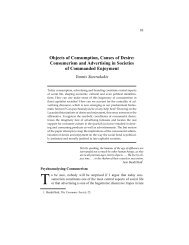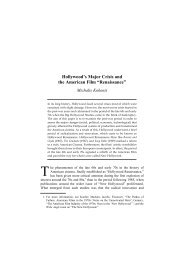19 International Symposium on Theoretical and Applied Linguistics ...
19 International Symposium on Theoretical and Applied Linguistics ...
19 International Symposium on Theoretical and Applied Linguistics ...
You also want an ePaper? Increase the reach of your titles
YUMPU automatically turns print PDFs into web optimized ePapers that Google loves.
G E N E R A L S E S S I O N<br />
(male / female) <strong>and</strong> word length (shorter ant<strong>on</strong>yms precede l<strong>on</strong>ger ant<strong>on</strong>yms – directly / indirectly,<br />
easy / difficult). As for the markedness criteri<strong>on</strong>, the results show that, rather than actively determining<br />
ant<strong>on</strong>ym sequence, it is itself subject to the influence of other sequencing criteria. However, the<br />
factors that rule ant<strong>on</strong>ym sequencing are not rigid rules <strong>and</strong> it is possible to flout the dominant word<br />
sequence. Analyzing some sentences in which the dominant word order is reversed we uncovered two<br />
main reas<strong>on</strong>s why this is possible. In the majority of cases the syntactic distance between ant<strong>on</strong>yms is<br />
greater than usual, so flouting the c<strong>on</strong>venti<strong>on</strong> is not so noticeable; or there appears to be a specific<br />
purpose in c<strong>on</strong>texts where some rhetorical effect may be intended, in which case semantic <strong>and</strong><br />
pragmatic c<strong>on</strong>diti<strong>on</strong>s govern the choice of ant<strong>on</strong>ym which is to be menti<strong>on</strong>ed first.<br />
Pragmatic competence for intercultural communicati<strong>on</strong>:<br />
theory <strong>and</strong> pedagogy<br />
Svetlana Kurteš<br />
University of Cambridge<br />
s.kurtes@googlemail.com<br />
The paper will discuss some aspects of acquisiti<strong>on</strong>al pragmatics <strong>and</strong> possible ways of its<br />
didacticisati<strong>on</strong>. More precisely, language teaching methodologies are increasingly acknowledging the<br />
fact that language learners, particularly those at more advanced stages of language proficiency, when<br />
attempting to decode the message <strong>and</strong> get its proper c<strong>on</strong>textual meaning, need to develop the right<br />
level of sophisticati<strong>on</strong> not <strong>on</strong>ly in their linguistic competences, but also in the pragmatic <strong>and</strong> cultural<br />
competences (Bailey 2003). Such competences should sensitise the learners to the discoursal <strong>and</strong><br />
pragmatic layers of meaning of the message <strong>and</strong> enable them to decode its metaphorical <strong>and</strong><br />
figurative levels – which can be very deeply culturally embedded – rather than interpreting the<br />
message <strong>on</strong>ly <strong>on</strong> the basis of its literary uses (Bailey 2003).<br />
It will be reiterated that pragmatic principles underlying the rules of usage of grammatical<br />
structures, often quite neglected in traditi<strong>on</strong>al reference <strong>and</strong> descriptive grammars <strong>and</strong> other relevant<br />
pedagogical materials, need to be established <strong>and</strong> analysed in the socio-cultural c<strong>on</strong>text in which the<br />
examined instances were found to be naturally occurring. It will then be shown how the basic c<strong>on</strong>cepts<br />
of the Theory of Cultural Scripts (Goddard <strong>and</strong> Wierzbicka 2007; Wierzbicka 2006) can be introduced<br />
into the foreign language classroom. The main c<strong>on</strong>struct of the theory refers to “a technique for<br />
articulating cultural norms, values <strong>and</strong> practices using the […] metalanguage of semantic primes as<br />
the medium of descripti<strong>on</strong>” (Goddard <strong>and</strong> Wierzbicka 2007: 105). These norms change c<strong>on</strong>stantly, so<br />
“in every period there are certain shared underst<strong>and</strong>ings <strong>and</strong> shared cultural norms that find their<br />
expressi<strong>on</strong> in a community’s ways of speaking” (Wierzbicka 2006: 9). Perhaps most importantly, the<br />
cultural norms <strong>and</strong> values in the theory of cultural scripts are described “from within rather than from<br />
outside”, […] form the point of view of those people who are the bearers of the postulated norms <strong>and</strong><br />
values (<strong>and</strong> in their own language)” (Wierzbicka 2006: 24).<br />
We shall c<strong>on</strong>clude by illustrating how the basic principles of the Theory of Cultural Scripts could<br />
find their practical didactic <strong>and</strong> potentially auto-didactic applicati<strong>on</strong>, helping the learners not <strong>on</strong>ly to<br />
improve their cultural fluency, but also gradually to develop relevant metacognitive strategies that will<br />
in turn ensure more successful <strong>and</strong> more aut<strong>on</strong>omous language learning <strong>and</strong> learning in general<br />
(Kurteš, 2008).<br />
References<br />
Bailey, R. 2003. C<strong>on</strong>ceptual metaphor, language, literature <strong>and</strong> pedagogy. Journal of Language <strong>and</strong> Learning,<br />
1:2; 59-72.<br />
Goddard, C. <strong>and</strong> Wierzbicka, A. 2007. Semantic primes <strong>and</strong> cultural scripts in language learning <strong>and</strong> intercultural<br />
communicati<strong>on</strong>. In F. Sharifian <strong>and</strong> G. B. Palmer (eds). <strong>Applied</strong> cultural linguistics: implicati<strong>on</strong>s for sec<strong>on</strong>d<br />
language learning <strong>and</strong> intercultural communicati<strong>on</strong>. Amsterdam: John Benjamins; 105-124.<br />
Kurteš, S. 2008. An investigati<strong>on</strong> into the pragmatics of grammar: cultural scripts in c<strong>on</strong>trast. In M. Pütz & J. Neff<br />
van Aertselaer (eds). Developing c<strong>on</strong>trastive pragmatics: interlanguage <strong>and</strong> cross-cultural perspectives.<br />
Berlin: Mout<strong>on</strong> de Gruyter; 65-83.<br />
Wierzbicka, A. 2006. English: meaning <strong>and</strong> culture. Oxford: Oxford University Press.<br />
<str<strong>on</strong>g>19</str<strong>on</strong>g> th ISTAL 29






